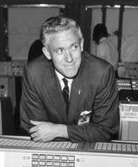John Hodge (engineer)
John Dennis Hodge (born 1929) is a British-born aerospace engineer. He worked for the CF-105 Avro Arrow jet interceptor project in Canada. When it was cancelled in 1959, he became a member of NASA's Space Task Group, which later became the Johnson Space Center. During his NASA career, he worked as a flight director and planner. When he returned to NASA in the 1980s, he worked as a manager on the Space Station Freedom project, which later became the International Space Station. He also served as an administrator at the United States Department of Transportation.
John Hodge | |
|---|---|
 John Hodge before the Gemini 4 mission. | |
| Born | 1929 (age 90–91) Leigh-on-Sea, Essex, England, United Kingdom |
| Nationality | British |
| Alma mater | Northampton Engineering College University of London |
| Scientific career | |
| Institutions | NASA |
Early life
Hodge was born in Leigh-on-Sea, Essex in 1929, and attended Minchenden Grammar School in Southgate, London. He studied at the Northampton Engineering College at the University of London, graduating in 1949 with a first-class degree in engineering. From 1950 through 1952 he worked as an engineer at Vickers-Armstrong in Weybridge. Upon graduation, Hodge worked as an engineer for the Aerodynamics Department of Vickers-Armstrongs. In 1952 Hodge took a job at the Avro Arrow project in Canada, where he was head of the air loads section.[1]
NASA career

When the Avro Arrow project was cancelled in 1959, 32 Avro engineers including Hodge followed the lead of Jim Chamberlin and migrated to join NASA's Space Task Group. The group, based at Langley Research Center in Hampton, Virginia, was responsible for America's manned space program, Project Mercury. At Langley, Hodge became the assistant to Chris Kraft, who was the head of the Space Task Group's operations division and NASA's first flight director.[2]
During John Glenn's historic 1962 Friendship 7 mission, the first orbital flight by an American, Hodge was serving as the flight director at NASA's tracking station in Bermuda.[3]
The final flight in the Mercury program, MA-9, was scheduled to last long enough that a second flight director was needed in Mission Control. Thus, in 1963, Hodge became a flight director, choosing blue as his team color. The missions that he worked included Gemini 8, where he was the first person other than Kraft to be lead flight director for a mission. Hodge was on-shift when a stuck Gemini thruster brought a rapid end to the mission. He was also on-duty during the launch test that resulted in the Apollo 1 fire.[4]
Hodge retired as a flight director in 1968, and became head of Johnson Space Center's advanced program office where he worked on preparing for the last three Apollo lunar landings and programs to follow Apollo. He left NASA in 1970 but returned in 1982 to run a large space station design study. When Space Station Freedom began in 1984, Hodge was named NASA’s Associate Administrator for Space Station, a post he held until leaving NASA in 1987.[5]
Career outside NASA
After leaving NASA in 1970, Hodge worked for the Transport Systems Center, Cambridge, Massachusetts, and the Urban Transportation Development Corporation in Toronto, Ontario, Canada, before serving five years as an administrator at the United States Department of Transportation. After leaving NASA in 1987, Hodge then formed his own firm, J. D. Hodge and Company, which was an international management and aerospace consultanting company.[1]
In Film
Hodge was portrayed by Jim Piddock in the 1998 miniseries From the Earth to the Moon. He was portrayed by Ben Owen in the 2018 film First Man.
Citations
- http://www.jsc.nasa.gov/history/oral_histories/HodgeJD/JDH_BIO.pdf
- Chris Gainor, ‘’Arrows to the Moon: Avro's Engineers and the Space Race.’’ Collector's Guide Publishing Inc., 2001. pp. 43-58, 74-87.
- Chris Gainor, ‘’Arrows to the Moon: Avro's Engineers and the Space Race.’’ Collector's Guide Publishing Inc., 2001. pp. 87-89.
- Chris Gainor, ‘’Arrows to the Moon: Avro's Engineers and the Space Race.’’ Collector's Guide Publishing Inc., 2001. pp. 90, 109-128, 150-152.
- http://www.jsc.nasa.gov/history/oral_histories/HodgeJD/JDH_4-18-99.pdf
References
- Gainor, Chris (2001). Arrows to the Moon: Avro's Engineers and the Space Race. Collector's Guide Publishing Inc. ISBN 978-1-896522-83-8.
- "Hodge, John D." (PDF). NASA Johnson Space Center Oral History Project Biographical Data Sheet.
- "Hodge, John D." (PDF). NASA Johnson Space Center Oral History Project. 10 April 1999. Retrieved 31 October 2006.
- Murray, Charles; Catherine Bly Cox (1989). Apollo: The Race to the Moon. New York: Simon and Schuster. ISBN 978-0-671-61101-9.
- Swenson, Jr., Loyd S.; James M. Grimwood & Charles C. Alexander (1989). This New Ocean: A History of Project Mercury. NASA. ISBN 978-1-4947-4096-2. Archived from the original on 23 August 2007.